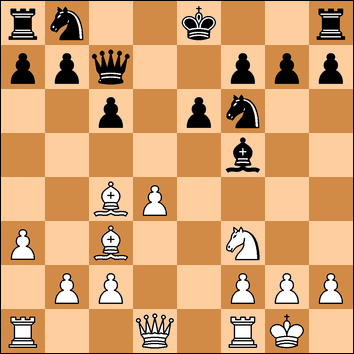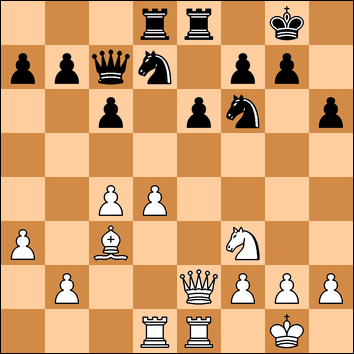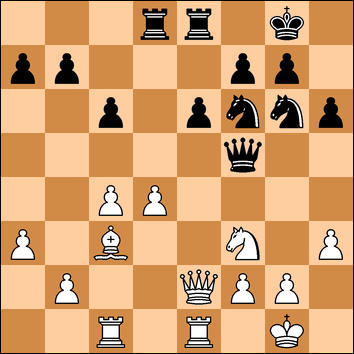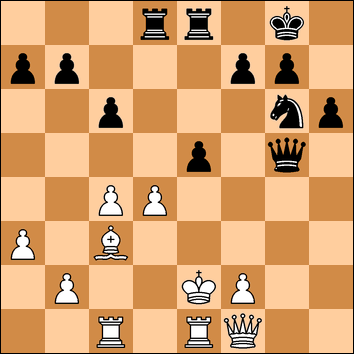Saturday 29 October 2016
White: K.Nevols (134) - Black: C.Siddo (134)
This was my first appearance for the Kent Under-140 county team. The game took place at the Mick Jagger Centre in Dartford. Next door were a group of children doing some sort of Halloween dance practice which meant all sorts of music came thumping through the walls.
I was initially concerned about this but actually found it relaxing. Jigging one's feet to 'Op, op, oppa Gangnam Style' while concentrating is quite therapeutic. Maybe disco chess is a creation waiting to happen.
The time limit is much more generous than I was used to. 35 moves in 105 minutes each and then half an hour for the rest of the game - so the whole game would be no more than four and half hours.
1. e4 d6
2. d4 Nf6
The Pirc Defence. Not an opening I know well yet I often seem to face.
3. Nc3 c6
4. Nf3 Bg4
5. h3 Bh5
The idea behind the early h3 was to deflect the bishop off the diagonal - and the move is often useful after castling anyway.
6. Be2 h6!?
If Black is playing the Pirc then he usually wants to put his bishop on the g7 square. I thought this move looked a bit loosening.
Now 7. e5 could deserve some consideration. A possible line being 7. .. dxe5 8. dxe5 Qxd1+ 9. Nxd1 Nd5 10. c4 or 10. Ne3 getting some initiative. However I am a cautious player and like to ensure the king is safe before I open the centre.
7. O-O e6
Perhaps the result of his last move. Black needs to put the kings' bishop somewhere and while g6 and Bg7 are still, in the long run possible, he decides it would be quicker to go to e7. The problem is that it gives this rather odd trio of pawns in his centre.
I now had a long thought of about twenty minutes. I have an advantage in development and wanted to see if I could make an early attack while Black still has some way to go. I considered 8. e5 dxe5 9. dxe5 Qxd1+ 10. Rxd1 but after 10. .. Nd7 or Nd5 could not see anything.
Black could at some stage play d5 to secure his centre and open the diagonal for the bishop. So I decided to preempt that and play the active move to try to open lines towards his uncastled king.
8. d5!
Now if 8. .. exd5 9. exd5 Nxd5 10. Nxd5 cxd5 11. Qxd5 (or a different order of exchanges but with the same result) then White has Re1 coming and Black has a weak pawn on d6 blocking in his bishop.
If Black continues development with 8. .. Nbd7 then 9. dxe6 fxe6 seemed to be OK.
Instead Black decides to close the centre.
8. ... e5
9. Nd2
Playing 9. Be3 might have been better. With my pawns on white squares it made sense to exchange the white squared bishop.
9. ... Bg6
I now rejected 10. f4 because after 10. .. exf4 11. Rxf4 I did not like the position of the rook nor the weak squares around the king. The computer now recommends 10. Bd3 but I do not like 10. .. cxd5 11. exd5 Bxd3 12. cxd3 although White now has the e4 square for his knight and Black is still behind in development.
Instead I decided to secure the centre and move the knight round to the e3 square.
10. Bf3 Be7
11. Re1 O-O
12. Nc4?
A bad mistake. If I wanted to play the knight to the e3 square then Nf1 would have been a better route. I now allow Black a sharp initiative.
12. . ....b5
Of course.
13. Nd2
Playing 13. Ne3 as per the original plan now results in 13. ... b4 winning a pawn.
13. ... b4
14. Nb1 cxd5
15. exd5 Qc7
And now things are looking a lot more gloomy. I have a pawn stuck alone on d5, most of my pieces stuck back on the first two ranks, while Black's bishop on g6 has come to life, his pawn on b4 does a good job of restricting White's queenside and he has pressure coming down the c-file. The tide is clearly in Black's favour.
I felt 16. c3 a5 did not get anywhere and so I decide to move forwards again to block the bishop diagonal.
16. Ne4 Nxe4
Developing with 16. .. Nbd7 might have been better.
17. Bxe4 f5
18. Bf3 Na6
Black brings his knight the other way but I think this is slightly inaccurate. 18. ...a5 would have kept the pressure on with Na6 behind the a-pawn or Nbd7. As played, I now get the chance to exchange off the restrictive pawn on b4.
19. a3 bxa3
20. Nxa3
Now I was a little more content. The knight on a3 defends the c2 point well, Black has an isolated a-pawn and my pieces are beginning to find some activity. However the d-pawn was still concerning me, as was Black's central pawns.
20. ... Qb7
The computer does not like this move which it states gives away Black's advantage. It prefers an idea of playing f4 and then Be8. To me, this move was to stop White moving the queen's bishop.
21. Rb1
This is to allow the queen's bishop to move. However 21. Nc4! is better, seizing the initiative, with the intention being to come to a5 and then possibly c6.
Black could now play 21. .. Nb4 to threaten e4 winning a pawn. Then 22. c4 e4 23. Be2 f4 and Black is on the march again. The knight is quite OK on the b4 square and will await the opportunity to jump it d3. (24. Nc2 e3!). Fortunately Black's knight chooses a less secure square.
21. . Nc5
22. b4 Na4
23. Rb3 Nb6
The knight's journey has resulted in the threat to the d-pawn forcing the next move. On the plus side, my rook had been forced to move to a square where it could consider moving across to the kingside.
24. c4
At the board I was now concerned about 24. .. Be8 with the intention of Ba4. However White can get back on the attack with 25. c5! But I cannot guarantee I would have seen this move.
24. . .. e4
25. Bh5
I played this because of my concern noted earlier. I did not want the black bishop to reach the a4 square and so decided to swap it off to ease some pressure on the centre and see if I could make anything of those white squares in front of his king.
25. . .... Bxh5
To my surprise, my opponent offered a draw. I say I was surprised because I had spent the last hour under the cosh trying to grovel out of the mistake made earlier with Nc4 and my mind had been set on survival. The computer rates the position now as '0' - dead level.
But I turned it down! Why? Did I think I was better? No, I certainly did not. Black still has the potential for operations on the queenside. The answer is that I was not ready yet to go home. I wanted to play on and see what happened.
26. Qxh5 Rf6
To defend against the threat of Bxh6. I now gave a lot of thought to 27. Rg3 renewing the threat to h6. If then 27. .. Kh8 then 28. Bb2 is strong. Black can counter attack with 27. ... Rf7 28. Bxh6 Rc8! 29. Rc1 f4 30. Rg6 Nxd5.
I could not see anything definite after this move and decided on the other way to attack.
27. Bb2 Rf7
28. f3
This is the best move but as soon as I played it I was regretting it. It makes perfect sense to open up the centre and bring the other rook into the attack but after 28. .. exf3 29. Qxf3 my hopes of an attack have gone again and I have too many pieces stuck over on the left hand side.
At the time, I thought I should be moving the knight into the middle with beautiful squares for it to sit on - such as c6, e6 and possibly f5 - so the d4 square is where it must go.
28. ... Nd7
Black re-routes the knight. Now the threat is Nc5 with the wonderful square d3 in sight. And Nf6 might also be a useful defensive move. The best way to meet this threat is with 29. Bd4 when Black might then consider 29. .. Bf6.
29. Nb5?
Mistake! Black can now counter attack against the c-pawn with 29. .. Rc8 30. Rc1 Nb6 31. Na3 Bg5 32. Rc2 Qa6 and White is all of a jumble once again.
29. .... a6?
Fortunately Black makes a mistake in return forcing the White knight to go where it was intending to go anyway.
30. Nd4
A lovely square for a knight and I was feeling happier with the world. How is Black going to defend the pawn on f5? I expected 30. . exf3 when I had to choose between 31. Nxf3 Nf6 (of 31. .. Nb6), 31. Qxf3 Ne5 or 31. gxf3 which just looked ugly.
30. ... Ne5
Not no. Black too gains an impressive knight in the centre. I decided to exchange my c-pawn for his e-pawn.
31. fxe4 Nxc4?!
With a second draw offer - but giving up a pawn. Better would have been 31. .. fxe4 32. Rxe4 Nxc4 and maybe then offering a draw. (33. Nf5 Nxb2 34. Rxb2 Bf6 and then defending the d-pawn - if White is in the mood for some fun, he could try 33. Nf5 Nxb2 34. Qxf7+!? Kxf7 35. Rxe7+ Qxe7 36. Nxe7 Kxe7 37. Rxb2 with a rook and four pawns ending. 37. .. Rb8 38. Re2+! Kd7 39. Re4 should hold the draw).
I decided to decline this second draw offer - again not because I could see a win, but because I wanted to see if I could make anything of the extra pawn.
32. Nxf5 Nxb2
33. Nxe7+?!
I figured that removing his bishop would weaken his defence - the problem is it also weakens my attack. That knight was doing very well on f5.
33. ... Qxe7
34. Rxb2 Rf4
Black now whips up some strong pressure on the centre.
35. Qe2 Qe5
36. Rb3 Qd4+
White should now play 37. Kh2 tucking the king away. Then perhaps 37. .. Rf2 38. Qe3 Qxe3 39. Rexe3 Rb8 and a draw is the most likely result.
37. Qe3?
And White blunders - from a pawn up to a pawn down.
37. ... Rxe4
I simply did not see this move. The d-pawn is doomed and I am now fighting for the draw.
38. Qxd4 Rxd4
In a state of shock, I picked up my rook from the e1 square and placed it on to e6 - for some reason, I had thought after Black plays Rxd5 I could then play Rxd6. Without letting go, I immediately saw my mistake, and lifted the rook back up again with the intention of putting it back - but I had forgotten where I had picked it up from.
I hovered, waving the rook in the air, and finally saw how I might be able to draw - by placing both rooks on the seventh rank with the plan of harassing his king.
39. Re7 Rxd5
40. Rc3
The intention is 40. Rcc7. Black now gave a lot of thought ...
40. .... Rb8
.... and offered the draw a third time. This time I gladly accepted to end an eventful game.
Black still has the advantage, and could not lose, so perhaps should have played on. 41. Rcc7 Rg5! 42. Ra7 Rxb4 43. Rxa6 Rb1+ 44. Kf2 Rb2+ will pick up the g-pawn after 45. Rxd6 Rgxg2. You could not say that Black has a win but it would have been hard work for White to hold.
My run of three wins had come to an end - but my roller coaster unbeaten run was continuing.



